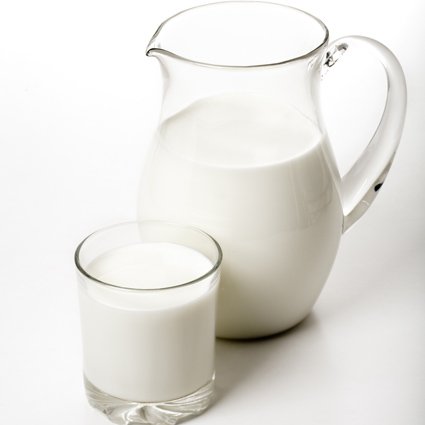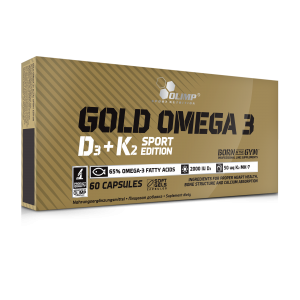Milk during weight loss – is it a good idea?

There is an opinion circulating among the bodybuilders that milk (and more broadly: dairy products) is not conducive to losing body fat. I am not entirely convinced of this notion, so let us look at what is in milk and see if we can identify possible culprits.
100 g of milk contains approximately:
3.3 g of protein (as a reminder: milk proteins can be divided into two factions – casein – 80% and whey – 20%)
4.8 g carbohydrates (lactose, otherwise known as milk sugar is a disaccharide built from simple sugars, galactose and glucose, in equal amounts)
different amounts of fat. Depending on the degree of processing, there are available on the market: whole milk – 3.2 g fat, skimmed milk – close to 0 g, and popular 2% milk.
The first suspect, naturally coming to mind, is obviously fat. One cup of the “fattest” carries a caloric load of approx. 150 kcal. However, if a physically active person drinks 8 glasses (and until recently milk was the most easily available and least expensive gainer, and this quantity was nor rare among those training), we end up with 1,200 kcal!
However, I can be fairly certain that such an idea will not come to mind of a person wishing to lose weight. Thus, the notion of excess calories due to fat contained in milk may be put aside.
What else can we find in milk?
Carbohydrates.
Indeed, each glass of milk contains about 12 g of carbohydrates in the form of lactose, which is a combination of popular glucose and galactose (another simple sugar). I am certain that most readers know the name “glucose”. Perhaps significantly less are aware what galactose is (6 g in a glass of milk). Galactose, like glucose (and fructose to which I will come back in a moment) is a monosaccharide. In contrast to glucose, it is less sweet and – more importantly – differently absorbed by the body. Galactose is preferentially transported to the liver to replenish the stored glycogen, which the body uses when the level of blood glucose go down. In this respect, it is more similar to fructose.
Again, a careful reader will note: fructose is not conducive to reducing body fat!
In part, I agree with this, as it is one of the hypotheses behind the reasons for rising obesity rates in the world (I will write another time about why I do not agree with it fully). However, let us go back to mathematics, since a glass of milk contains 6 g of galactose (similar to fructose) and the “safe” daily allowance for fructose ranges from 50-100 grams per (depending on which author / researcher you ask). Thus, how many glasses we would have to drink to get closer to the lower limit? The answer is provided by the calculator – again, about 8 – and remember this is 1,200 kcal! I cannot imagine a person on a diet who drinks so much milk. Unless this is (virtually) the only food they consume. If it the case, there are bigger problems involved than the effect of milk fat. Carbohydrates (directly) are also NOT guilty.
So maybe something else?
If you read my publications in the Perfect Body magazine (or carefully read scientific reports), you will remember a weak relationship between drinks and the suppression of hunger. Those who have not heard of this notion, should know that what we drink usually does not inhibit strongly the feeling of hunger. It is also another potential culprit of the U.S. obesity epidemic. But, just as the theory of excess calories from milk, this argument also does not stand the test of time (and research). Milk is just a notable exception – the body (because of the content of all major macronutrients) perceives it in a manner unique among liquids. After a glass of milk we will, therefore, feel less hungry than after drinking an analogous amount of water or sweetened beverages (very popular, especially among youth).
Let us look at the next idea that comes to mind, which you can possibly blame for the perception of needing to abandon milk during dieting – an allergic reaction to milk. Different populations suffer from lactose intolerance to varying degrees. Fortunately (of course statistically), we Poles, as a nation, are not particularly vulnerable. In Europe, the highest incidence of lactose intolerance can be found among the inhabitants of the Mediterranean regions. For most people, intolerance is limited to the ailments of the digestive system such as bloating, abdominal pain, etc. A certain percentage of the population may additionally suffer from intolerance of other milk components. And if I were to blame only one perpetrator responsible for the emergence of thesis about the bad influence of dairy products on the process of reducing body fat, it would be the allergic reactions.
Interestingly, most reservations to the justification of including milk and dairy products in the diet are brought about by strength sports athletes during the peri-competition period. When the level of fat in the human body drops to low values, and remember that the best athletes on the scene have 2 3% fat in their body (!), various unusual things begin to happen. Perhaps the combination of milk with low body fat (and perhaps (2) of individual reactions in the form of allergies) causes problems for which dairy products are blamed? I have not yet come across a definitively conclusive answer – therefore, for now I will stick to my feelings.
As we have already checked whether, what and potentially when can cause problems with body shape due to the consumption of dairy products, let us again consider if there might be some advantages from consumption of milk and dairy products for facilitating fat loss.
I guess I do not have to convince anybody that milk is considered one of the best sources of calcium. Also, the fact that calcium supports the good condition of our bones is not a secret for most of us. But the effect that calcium has on the rate of fat loss may not be so obvious.
And yet!
Numerous studies have shown a significant positive effect of the amount of calcium intake on the speed of fat loss. It thus appears that milk and dairy products may not only hinder the reduction, on the contrary – they may facilitate it! What a paradox!
There is one more thing I would like to discuss before closing the article.
Perhaps it seems marginal, in the whole picture of milk effects on fat loss, yet still noteworthy when we stringently restrict calories, to provide adequate (usually large) amount of protein. And yet there are few things as delicious as a good high-protein supplement prepared on milk (especially during a diet with limited sweets).
It seems to me, therefore, that with a clear conscience I can wish the vast majority of readers:
Enjoy a tasty shake with your favourite flavour Pro Long Protein with milk.
Zbyszko Tarczewski
BACK ›

